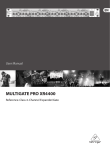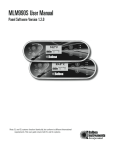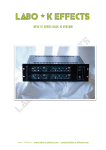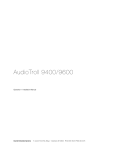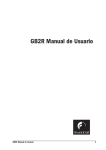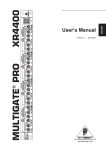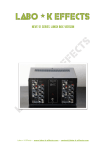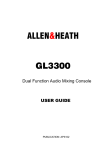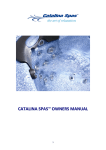Download ALLEN&HEATH GL2200 - FC
Transcript
ALLEN&HEATH GL2200 Dual Function Audio Mixing Console USER GUIDE PUBLICATION: AP3388 LIMITED ONE YEAR WARRANTY This product has been manufactured in the UK by ALLEN & HEATH and is warranted to be free from defects in materials or workmanship for period of one year from the date of purchase by the original owner. To ensure a high level of performance and reliability for which this equipment has been designed and manufactured, read this User Guide before operating. In the event of a failure, notify and return the defective unit to ALLEN & HEATH or its authorised agent as soon as possible for repair under warranty subject to the following conditions: CONDITIONS OF WARRANTY 1. The equipment has been installed and operated in accordance with the instructions in this User Guide. 2. The equipment has not been subject to misuse either intended or accidental, neglect, or alteration other than as described in the User Guide or Service Manual, or approved by ALLEN & HEATH. 3. Any necessary adjustment, alteration or repair has been carried out by ALLEN & HEATH or its authorised agent. 4. The defective unit is to be returned carriage prepaid to ALLEN & HEATH or its authorised agent with proof of purchase. 5. Units returned should be packed to avoid transit damage. These terms of warranty apply to UK sales. In other territories the terms may vary according to legal requirements. Check with your ALLEN & HEATH agent for any additional warranty which may apply. GL2200 User Guide AP3388 Issue 4. Copyright © 2001 Allen & Heath Limited. All rights reserved This product complies with the European Electromagnetic Compatibility Directives 89/336/EEC & 92/31EEC and the European Low Voltage Directives 73/23/EEC & 93/68 EEC MANUFACTURED IN ENGLAND BY: Allen & Heath Limited Kernick Industrial Estate Penryn, Cornwall, TR10 9LU. UK http://www.allen-heath.com ALLEN&HEATH CONTENTS CONTENTS .......................................................................................................3 INTRODUCTION, SERVICE, SAFETY & PRECAUTIONS ............................................4 KEY FEATURES, THE RANGE & OPTIONS.............................................................5 CONNECTING POWER TO THE CONSOLE .............................................................6-7 EARTHING THE AUDIO SYSTEM ...........................................................................7 PLUGGING UP THE CABLES.................................................................................8-9 ADJUSTING THE LEVELS .....................................................................................9 FLIGHTCASING THE CONSOLE.............................................................................10 MONO INPUT CHANNEL .....................................................................................11-12 STEREO INPUT CHANNEL ...................................................................................13-14 STEREO RETURNS & AUX MASTER OUTPUTS ....................................................15 GROUP OUTPUTS .............................................................................................16 MODE SWITCHING .............................................................................................17 MASTER & MONITOR .........................................................................................18 OSCILLATOR/PINK NOISE & TALKBACK ...............................................................19 APPLICATION – FRONT OF HOUSE .....................................................................20 APPLICATION – STAGE MONITOR .......................................................................21 APPLICATION – DUAL MODE .............................................................................22 FRONT PANEL LAYOUT ......................................................................................23 REAR PANEL LAYOUT / SPECIFICATIONS & CONNECTIONS ...................................24 INTERNAL LINK OPTIONS ...................................................................................25 CUE SHEETS ....................................................................................................26-27 GL2200 BLOCK DIAGRAM .................................................................................COVER GL2200 USER GUIDE 3 INTRODUCTION The GL2200 continues ALLEN & HEATH’s commitment to provide high quality audio mixing consoles engineered to meet the exacting requirements of today’s audio business. It brings you the latest in high performance technology and offers the reassurance of over two decades of console manufacture and customer support. This user guide presents a quick reference to the function, application and installation of the GL2200. We recommend that you read this guide fully before operating the console For further information on the basic principles of audio system engineering please refer to one of the specialist publications available from bookshops and audio equipment dealers. Whilst we believe the information in this guide to be reliable we do not assume responsibility for any inaccuracies. We also reserve the right to make changes in the interest of further product development. SERVICE AND TECHNICAL SUPPORT Under normal conditions the GL2200 does not require user maintenance or internal calibration. Any service work required should be carried out by qualified service personnel only. We are able to offer further product support through our world-wide network of approved dealers and service agents. You can also access our Web site on the internet for information on our product range, assistance with your technical queries or simply to chat about audio matters. To help us provide the most efficient service please keep a record of the console serial number, and date and place of purchase to be quoted in any communication regarding this product. SAFETY WARNING! Mains electricity is dangerous and can kill. Mains voltage is present within the console power supply. Do not remove the power supply cover with mains electricity connected. To ensure your safety, mains earth is connected to the chassis through the power lead. Do not remove this mains earth connection. To avoid the risk of fire, replace the mains fuse only with the correct value and type as indicated on the power supply unit. GENERAL PRECAUTIONS Your GL2200 is ruggedly constructed to give many years of reliable operation. However, you will extend the life of the console and preserve its cosmetics by applying these simple common sense precautions. • Avoid storing or using the mixing console in conditions of excessive heat or cold, or in positions where it is likely to be subject to vibration, dust, dirt or moisture. • Do not use any liquids to clean the control surface of the console, a soft dry brush or dry lint-free cloth is ideal. • Use only water or ethyl alcohol to clean the trim and scribble strips. Other solvents may cause damage to paint or plastic parts. • The faders, switches and potentiometers are lubricated for life. The use of electrical lubricants on these parts is not recommended. • Avoid using the console close to strong sources of electromagnetic radiation (e.g. video monitors, high power electric cabling): this may cause degradation of the audio quality due to induced voltages in connecting leads and chassis. For the same reason, always site any external power supply away from the unit. 4 GL2200 USER GUIDE KEY FEATURES OF THE GL2200 The ALLEN & HEATH GL2200 offers the user the versatility to quickly adapt to the exacting demands of live sound engineering today. The GL2200 is developed from the very successful GL2000 console, which included mode switching to quickly convert the console from Front-of-House to On-stage Monitor operation. In addition, the GL2200 includes 4 subgroups, 6 independent aux sends, stereo mic/line channels, pink noise generator, 1kHz oscillator and lots more. It is built on the established tradition of innovative British design and manufacture. The GL2200 is equally suited to home and studio recording. Features include: • FOH/stage-monitor dual functionality • 4 groups, 6 auxes • Groups, L, R and Mono outputs on balanced XLR • 12, 16, 24 and 32 channel frames • 2 stereo line channels with mic capability • 2 stereo returns with mutes, faders, EQ and Aux sends • Mutes on Groups and L-R • Channel direct outs • 2-track send and return • 4-band EQ with swept mids and in/out switch • Input metering on each channel • Phantom Power 48V, switchable on each channel • Inserts on all mono inputs • Inserts on Groups (auxes) and L-R outs • Comprehensive AFL/PFL monitoring • Pink noise generator for speaker setup • Oscillator for equipment line up • Talkback facility • High-performance internal power supply with universal mains input voltage • Built-in combiner to add external backup power supply • Console lamp connector • Sys-linkTM expandability • Rugged build quality The console is constructed using zinc plated steel panels and 1.6mm thick metal side plates. Individual circuit board assemblies are accessible by removal of the steel base. A durable soft front armrest is provided for comfort. A channel top write-on strip is provided for channel marking. High quality reliable parts are used throughout. High performance op-amp and discrete circuits are used to ensure low noise and sonic purity. The internal power supply is a low noise switch mode unit that can be linked with an external DC power supply. THE RANGE 12, 16, 24 and 32 channel models GL2200-412 10 mono, 2 stereo, 4 groups, 6 aux, 2 stereo returns, L, R, Mono sum GL2200-416 14 mono, 2 stereo, 4 groups, 6 aux, 2 stereo returns, L, R, Mono sum GL2200-424 22 mono, 2 stereo, 4 groups, 6 aux, 2 stereo returns, L, R, Mono sum GL2200-432 30 mono, 2 stereo, 4 groups, 6 aux, 2 stereo returns, L, R, Mono sum OPTIONS GL2200-SL1 RPS9 Sys-link buss expander, one kit per console 2U rack mount power supply for backup GL2200 USER GUIDE 5 CONNECTING POWER TO THE CONSOLE Refer to the SAFETY WARNING on page 4 of this User Guide. Read and understand the warnings and instructions printed on the rear panel of the console and printed here. Ensure adequate ventilation around the console. Do not cover the console or position it on soft furnishings during operation. The console must be connected to 0V ground by either the a.c. mains input cable or by the EXTERNAL DC IN cable. CAUTION: FOR CONTINUED PROTECTION AGAINST RISK OF FIRE REPLACE FUSE WITH SAME TYPE AND RATING. ATTENTION: REMPLACER LE FUSIBLE AVEC UN DES MEMES CARACTERISTIQUES. WARNING: DISCONNECT SUPPLY BEFORE CHANGING FUSE. ATTENTION: COUPER L'ALIMENTATION AVANT DE CHANGER LE FUSIBLE. 100 - 240V~ EXTERNAL SUPPLY ACTIVE INTERNAL SUPPLY ACTIVE T1A 250V 20mm WARNING - THIS APPARATUS MUST BE EARTHED. SUPPLY VOLTAGE RANGE: 100 - 240V.AC 47-63Hz ~ 60W MAX WARNING: TO REDUC SEE INSTA DO NOT OB NO USER S The GL2200 console can be powered from either the internal power supply, from an external DC supply such as the Allen & Heath RPS9, or both together. The LED indicators on the rear panel illuminate to indicate which supply is active. Normally the internal power supply will be used to power the console by the standard 3 pin IEC mains input connector. A mains cable with moulded mains plug suitable for the local supply is supplied. Check that the correct mains lead with moulded plug has been supplied with your console. Ensure that the IEC mains plug is fully inserted into the rear panel socket before switching on. POWER SUPPLY The internal power supply for the GL2200 is a switch mode supply and will operate from a wide range of mains input voltages. It produces the DC voltages required by the console. Before switching on your console, check that the ac mains fuse is of the correct type and rating. This is clearly marked on the rear panel of the console. Do not replace the fuse with any other type, as this could become a safety hazard and will void the warranty. AC~ mains input voltage Fuse value 100 - 230V ±10% T 1A 250V 20mm CAUTION: For continued protection against the risk of fire, replace fuse only with the correct type and value. The console power supply unit contains no user serviceable parts. Do not remove the cover. Refer servicing to qualified service personnel only. 6 GL2200 USER GUIDE An external DC supply may be used instead of, or together with the internal supply. Use only recommended Allen & Heath power supplies or a supply approved by Allen & Heath. The use of alternative supplies is not recommended and may cause damage. The pin connections for the EXTERNAL DC IN connector are specified below: Pin Voltage Current 1 -16V 1.5A 2 Audio 0V 3 Chassis 0V 4 +16V 1.5A 5 +48V 0.1A In the absence of an active 100V to 230V a.c. mains supply, the GL2200 will automatically switch over to the external DC supply unit if connected. Always turn connected power amplifiers down or off before switching the console on or off. In the event of an electrical storm, or large mains voltage fluctuations, immediately switch off and disconnect all power to the console. EARTHING THE AUDIO SYSTEM The console chassis is connected to mains earth via the power cable. Audio 0V is connected internally to the chassis and therefore mains earth. In this way all signal returns and connector shields are connected to mains earth at the console. To ensure safety, do not remove the earth connection from the AC mains plug or from EXTERNAL DC IN cable. For best performance it is important that the earth system is solid, clean and noise-free. To prevent mains-borne and external interference pickup from lighting equipment, motors and other mains powered equipment it is recommended that a separate ‘clean’ mains distribution outlet is used for the audio system. All signal cables should have their screens connected to earth at the connector. If earth (ground) loop problems result in audible hum or buzz then disconnect the cable screen connection at one end, usually the destination end. This may be done within the cable plug or by operating the ‘ground lift’ switch if available on the connected equipment. Many DI boxes and power amplifiers include this facility. GL2200 USER GUIDE 7 PLUGGING UP THE CABLES The GL2200 uses professional grade 3-pin XLR, 1/4" TRS jack and RCA PHONO sockets. Where possible use balanced connections to prevent noise and interference pickup especially on long cable runs. Avoid running audio cables next to AC mains, computer or lighting cables, near thyristor dimmer units or power supplies etc. The use of low impedance sources such as good quality microphones of 200 ohms or less significantly reduces interference pickup. Many problems can be avoided by taking time to check that all cables are correctly wired. Avoid reversing + and - on balanced connections as this will result in out of phase signals (reverse polarity) causing signal cancellation effects. This situation is particularly common in multimicrophone mixing. Use professional quality cable and carefully soldered connections. The following wiring convention is used: XLR ¼” TRS jack Pin 1 0V earth shield Tip + / hot / signal / left / send Pin 2 + / hot / signal Ring - / cold / 0V / right / return Pin 3 - / cold Sleeve 0V earth shield CABLE WIRING Tip 1 OUTPUT Ring Sleeve Tip Ring BALANCED Sleeve 3 2 CONSOLE CONNECTIONS 3-PIN XLR FEMALE PLUG TWIN SCREENED CABLE 2 INPUT 3 1 ¼" 3-POLE (STEREO) JACK PLUG 3-PIN XLR MALE PLUG Tip 1 OUTPUT 3 2 Link Sleeve Sleeve Tip UNBALANCED 3-PIN XLR FEMALE PLUG SINGLE SCREENED CABLE CONSOLE CONNECTIONS 2 INPUT 3 1 ¼" 2-POLE (MONO) JACK PLUG 3-PIN XLR MALE PLUG Sleeve Ring CONSOLE CONNECTIONS Tip Ring SINGLE SCREENED CABLE UNBALANCED Tip Sleeve OUTPUT Link INPUT RCA PHONO PLUG ¼" 3-POLE (STEREO) JACK PLUG To connect an unbalanced source to a balanced console input, link the cold input (XLR pin 3 or jack ring) to 0V earth (pin 1 or jack sleeve) at the console. To connect a balanced console output to an unbalanced destination link the cold output to 0V earth at the console. Deselect input channel +48V when inputs are connected to non-phantom powered, mic, line or unbalanced sources. 8 GL2200 USER GUIDE CONNECTING CHANNEL INPUTS Both microphone and line sources such as keyboards, replay devices and effects processors can be plugged into either the jack or XLR input for convenience. The channel accepts a wide 70dB range of source levels. The balanced 3-wire input provides the best immunity to interference pickup on long cable runs. CONNECTING TO INSERTS You do not need to plug anything into the insert socket for normal operation. You may, however wish to insert a signal processor such as a compressor/limiter or noise gate into the signal path to prevent excessive peaks or to cut down source noise. The insert lets you do this by breaking the signal path after the input pre-amp and before the EQ in the channel input or before the fader in the Group and L-R section. Use a Y-lead or suitable TRS jack lead to connect to the external processor. The insert operates at 0dBu line level in the channel input and –2dBu in the Group and L-R section. Adjust the processor input and output levels for optimum signal level. CHANNEL DIRECT OUTPUTS The channel direct output taps the signal off post-fader (pre-fader if the internal link option is changed) for connection to external processing or recording equipment. This is ideal for multitrack recording during a live performance. Here each channel can be recorded on a separate track for mixdown later. The output is impedance balanced on TRS jack. This means that you get the benefit of interference immunity when connecting to outboard equipment with balanced inputs. You can, of course, also connect to unbalanced equipment. The signal operates at nominal 0dBu line level. ADJUSTING THE LEVELS For best performance it is important that the connected source signals are matched to the “normal operating level” of the console. Similarly the console outputs should be correctly matched to the operating levels of the connected amplifiers and destination equipment. If too high, the signal peaks will be clipped resulting in a harsh distorted sound, and if too low, the signal-to-noise ratio is reduced resulting in excessive background hiss. For best results, operate the console with the meters averaging ‘0’ or just below and allowing the loudest passages and occasional peaks into the ‘yellow’. Reduce the gain if the peak indicators flash (red). The GL2200 provides +4dBu output level at the XLR outputs for a meter reading of 0VU. It is advisable to adjust the power amplifier input gain or fit an attenuator pad if normal console operation results in an output level too high for the connected amplifier. Normal operation should give rise to fader levels around the ‘0’ mark. The GL2200 has an advanced PFL (pre-fade listen) / AFL (after-fader listen) and channel metering system to let you listen to and check the level of signals at different points in the signal path without affecting the main outputs. Use the channel PFL switches to set up the input GAIN controls to read an average ‘0’ (yellow LED). Signal activity is always shown on the channel meters regardless of fader position. The green ‘SIG’ LED lights at -20dBu to indicate signal presence, the yellow ‘0’ LED indicates normal level, and the red ‘PEAK’ LED warns of potential overload 5dB before clipping. GL2200 USER GUIDE 9 FLIGHTCASING THE CONSOLE If the console is to be regularly moved we recommend that it is installed in a foam-lined flightcase. At all times avoid applying excessive force to any knobs, switches or connectors. Dimensions for flightcasing the console are shown below: DIMENSIONS Unpacked Packed Width depth height weight(kg) Width depth height weight(kg) GL2200-412 ........................548 ............ 572 ............ 155 ............ 16.....................700 ............ 750 ............ 280 ............ 20 GL2200-416 ........................668 ............ 572 ............ 155 ............ 18.....................815 ............ 750 ............ 280 ............ 23 GL2200-424 ........................920 ............ 572 ............ 155 ............ 24.....................1065 .......... 750 ............ 280 ............ 29 GL2200-432 ........................1160 .......... 572 ............ 155 ............ 30.....................1325 .......... 750 ............ 280 ............ 35 RPS9 power supply ............483 ............ 140 ............ 96 ............. 6......................540 ............ 270 ............ 180 ............ 8 10 GL2200 USER GUIDE MONO INPUT CHANNEL The mono input channel is designed using a very high quality analogue signal path to ensure absolute sonic purity for microphone or line level sources. 48V 1 Ø PAD -30dB 0 GAIN 40 30 MIC INPUTS Plug a microphone source into the XLR input. If you leave the jack input unplugged then the PAD (LINE) switch becomes a 30dB pad for the microphone. This lets you use the XLR input for high output microphones, or for line level sources. LINE INPUTS Plug a line level source into either the XLR or the TRS jack input. If you use the XLR input make sure that you do not plug anything into the jack input, and that you press the PAD (LINE) switch. If you use the TRS jack input make sure that you press the PAD (LINE) switch. The jack input is only selected with this switch pressed. 50 PAD - 10 20 60 30 100Hz 0 HF 12kHz -15 + 15 3kHz 500Hz 15kHz 0 MF1 -15 + 15 250Hz 35Hz 1kHz 0 MF2 -15 48V selects +48V to the XLR input for microphones that require phantom power. IMPORTANT NOTE : Switch off channel +48V when non-phantom powered mic, line or unbalanced sources are to be used with the inputs. + 15 0 LF 60Hz -15 + 15 EQ IN AUX 1 φ reverses the POLARITY of the input source to correct the problems often encountered in microphone placement, or due to incorrectly wired cables (pin 3 hot instead of pin 2). May also helpful in reducing acoustic feedback between closely positioned loudspeakers and mics in live sound mixing. PAD (LINE) selects the line level jack input when pressed or becomes a 30dB pad for the XLR input when no jack is plugged in. The XLR is normalled through the unplugged jack contacts. See MIC/LINE description above. GAIN matches the level of the input source to the normal operating level of the console. Adjust this to read an average ‘0dB’ on the channel meter (yellow LED). Use the PFL system to listen to the signal and fine tune the gain. 0 OO +6 OO +6 OO +6 OO +6 AUX 2 0 AUX 3 0 AUX 4 0 PRE AUX 5 0 OO +6 OO +6 AUX 6 100Hz 18dB/Octave lo-cut filter removes low frequency noise such as microphone pops, proximity effect, stage noise and transport rumble after the pre-amp stage. It can also be used to clean up sounds that do not have much bass content, such as vocals and cymbals. The lo-cut filter is independent of the equaliser. 0 PRE C PAN ODD L The 4-band EQ lets you adjust the tonal quality of the sound. The LF (bass) bands have a shelving response, which means that beyond the corner frequency are affected. Used with the 100Hz can tailor the low frequency response exactly as you require. position is detented for quick resetting. EVEN R MUTE PEAK +6 0 10 SIG HF (treble) and all frequencies lo-cut filter you The centre flat 5 AMPL(dBr) vs FREQ(Hz) PFL L-R 0 10.00 5 0.0 1-2 -10.00 10 3-4 -20.00 -30.00 20 -40.00 30 OO -50.00 -60.00 10 100 1k 10k 20k 100 Hz lo-cut filter GL2200 USER GUIDE HF and LF EQ 11 48V 1 Ø PAD -30dB 0 GAIN The 2 mid frequency bands MF1 and MF2 can be swept across a wide frequency range to tune into the exact frequency required; useful for getting the best out of microphones or for tuning out troublesome feedback. The mid bands are overlapping with a Q of 1.6 and can boost or cut in excess of +/- 15dB. The centre flat position is detented for quick resetting. 40 30 50 PAD - 10 20 60 30 100Hz 0 HF 12kHz -15 + 15 3kHz 500Hz 15kHz 0 MF1 -15 + 15 250Hz 35Hz 1kHz 0 MF2 -15 + 15 MF1 EQ 0 LF 60Hz -15 + 15 EQ IN AUX 1 0 OO +6 OO +6 OO +6 OO +6 AUX 2 0 AUX 3 0 AUX 4 0 PRE AUX 5 0 OO +6 OO +6 AUX 6 0 PRE C PAN ODD L EVEN R MUTE PEAK +6 0 10 SIG 5 PFL 0 L-R 5 1-2 10 3-4 20 30 OO 12 MF2 EQ Press EQ IN to switch the EQ into the signal path. 6 AUX SENDS provide feeds for foldback monitors and effects. Aux 1-4 and Aux 5-6 may be set to pre or post-fader using the PRE switch. Monitor sends to the performers are usually set pre-fade (PRE), although some sources such as radio mics are often set post-fade to avoid ‘dressing room’ talk spill. Effects sends to external signal processing equipment such as reverb and delay effects units, are usually set post-fade so that the amount of effect (wet signal) is always relative to the position of the fader (dry signal). Adjust the amount of effect required for each channel using its AUX control. The effect is returned to the mix through another channel, usually the stereo return described later in this guide. POST-FADE sends are post-EQ, post-mute. PRE-FADE sends are set post-EQ, post-mute as standard. Internal link options are available to change the source of the pre-fade sends. Refer to the internal link options section in this user guide. Note; AUX 1-6 feed XLR outputs with inserts when the GRP/AUX REVERSE switches are pressed in the master section. PAN positions the channel signal within the stereo image or between L-R and the groups when the routing switches are selected. The centre position is detented for quick resetting. MUTE switches the signal off when pressed regardless of fader position. Muted channels are indicated by red LEDs. The channel meter continues to indicate prefader channel activity. A 4 LED CHANNEL METER shows signal activity at all times. The green SIG LED indicates signals greater than -20dBu, yellow ‘0’ and ‘+6’ represents normal operating level, and red PEAK warns of potential overload 5dB before clipping. Set the channel signal so that the meter averages between ‘0’ and ‘+6’. Back the gain off if the red peak LED flashes. Pressing PFL lets you listen to the channel pre-fader signal on headphones without interrupting the main console outputs. The signal level is shown on the LR bargraph meters. In this way each sound can be correctly lined up and checked at any time. L-R, 1-2, 3-4 routing switches feed the channel signal to the L-R mix and groups 1-2, 3-4. Use the pan control to route to individual groups, i.e. left to route to L, 1, 3 and right to route to R, 2, 4. In this way subgroups may be set up in mono or stereo to feed the main L-R mix. A 100mm FADER provides +10dB boost above the normal ‘0’ operating level. All post-fade aux send levels are dependent on the level of the fader. GL2200 USER GUIDE STEREO INPUT CHANNEL Two stereo input channels are included as standard. Each features a 4-band EQ, 6 aux sends and group routing. Use this channel for stereo sources such as keyboards and two track players, or for returning additional effects processors to the mix and monitors. A mic input is included so that you can use the channel for additional mics when needed. The stereo line input can still be routed to the mix while using the channel mic input. The stereo inputs are on separate TRS jacks. For mono line sources plug into the L/MONO jack socket only. For microphone sources plug into the XLR. 48V 12 Ø 30 20 40 50 MIC GAIN 60dB 10 MIC TO TALK 10 0 LINE GAIN OO 20 LINE TO L-R MIC LINE 0 HF 12kHz -15 + 15 0 MF1 2.5kHz -15 + 15 0 MF2 250Hz -15 + 15 0 LF 60Hz -15 + 15 EQ IN AUX 1 0 OO +6 OO +6 OO +6 OO +6 AUX 2 0 AUX 3 0 AUX 4 0 MIC TO TALK ENABLE 48V selects +48V DC to the XLR input for microphones that require phantom power. IMPORTANT NOTE : Switch off channel +48V when non-phantom powered or unbalanced sources are connected to the XLR input. φ reverses the POLARITY of the input source to correct problems often encountered in microphone placement, or due to incorrectly wired cables (pin 3 hot instead of pin 2). May also be helpful in reducing acoustic feedback between closely positioned loudspeakers and mics in live sound mixing. GAIN controls for the MIC and LINE inputs let you adjust each source independently. LINE TO L-R routes the stereo line source direct to the L-R mix. In this way both the mic and stereo line inputs may be used at the same time. The mic can be routed through the stereo channel while the line input becomes an independent source or return to the LR mix. MIC/LINE selects either the mic XLR or the stereo line jack inputs to the channel. When selecting LINE on the second stereo input channel, the MIC input section is available as the source for talkback. A green LED indicator illuminates to confirm this. The channel can be used with the stereo line input in the normal way while the mic is independently used for talkback. PRE AUX 5 0 OO +6 OO +6 AUX 6 0 PRE C BAL ODD L EVEN R MUTE PEAK +6 0 10 SIG 5 PFL 0 L-R 5 1-2 10 3-4 20 30 OO STEREO 15-16 The 4-band stereo EQ lets you adjust the tonal quality of the sound. The HF (treble) and LF (bass) bands have a shelving response, which means that all frequencies beyond the corner frequency are affected. The 2 mid frequencies MF1 and MF2 provide optimum control over boomy or boxy sounds (250Hz), and can add bite or reduce harshness to keyboards, vocals etc. (2.5kHz). The centre flat position is detented for quick resetting. 6 AUX SENDS provide feeds for foldback monitors and effects. Aux 1-4 and Aux 5-6 may be set to pre or post-fader using the PRE switch. The left and right stereo signals are summed to provide aux feeds in mono. Monitor sends to the performers are usually set pre-fade (PRE), although some sources such as radio mics are often set post-fade to avoid ‘dressing room’ talk spill. Effects sends to external signal processing equipment such as reverb and delay effects units, are usually set post-fade so that the amount of effect (wet signal) is always relative to the position of the fader (dry signal). Adjust the amount of effect required for each channel using its AUX control. The effect is returned to the mix through another channel, usually the stereo return described later in this guide. POST-FADE sends are post-EQ, post-mute. PRE-FADE sends are set postEQ, post-mute as standard. Internal link options are available to change the source of the pre-fade sends. Refer to the internal link options section in this user guide. Note; AUX 1-6 feed XLR outputs with inserts when the GRP/AUX REVERSE switches are pressed in the master section. GL2200 USER GUIDE 13 48V 12 Ø 30 20 40 50 MIC GAIN 60dB 10 MIC TO TALK 10 0 LINE GAIN OO 20 LINE TO L-R MIC LINE 0 HF 12kHz -15 + 15 0 MF1 2.5kHz -15 + 15 0 MF2 250Hz -15 + 15 0 LF 60Hz -15 + 15 EQ IN AUX 1 MIC TO TALK ENABLE BAL positions the channel signal within the stereo image or between L-R and the groups when the routing switches are selected. The centre position is detented for quick resetting. MUTE switches the signal off when pressed regardless of fader position. Muted channels are indicated by red LEDs. The meter continues to indicate pre-fader channel activity. A 4 LED CHANNEL METER shows signal activity. The green SIG LED indicates signals greater than -20dBu, yellow ‘0’ and ‘+6’ represents normal operating level, and red PEAK warns of potential overload 5dB before clipping. Set the channel signal so that the meter averages between ‘0’ and ‘+6’. Back the gain off if the red peak LED flashes. Pressing PFL lets you listen to the channel pre-fader signal on headphones without interrupting the main console outputs. The signal level is shown on the L-R bargraph meters. In this way each sound can be correctly lined up and checked at any time. L-R, 1-2, 3-4 routing switches feed the channel signal to L-R mix and groups 1-2, 3-4. Use the pan control to route to individual groups, ie left to route to L, 1, 3 and right to route to R, 2, 4. In this way subgroups may be set up in mono or stereo to feed the main L-R mix. A 100mm FADER provides +10dB boost above the normal ‘0’ operating level. All post-fade aux send levels are dependent on the level of the fader. 0 OO +6 OO +6 OO +6 AUX 2 TALKBACK SIGNAL TO OSC/TALKBACK 0 AUX 3 0 AUX 4 MIC TO TALK ENABLE (LAST STEREO ONLY) GAIN 0 OO MIC IN +6 2= + x2 PFL 4-BAND EQUALISER + PRE STEREO CHANNEL PEAK + 6dB 0dB SIG FADER HF AUX 5 + 48V 0 OO MIC/ LINE +6 AUX 6 MF1 L R 0 OO +6 EQ IN BAL MUTE + MF2 L-R 1-2 POST 3-4 LF PRE C BAL ODD L EVEN R MUTE L/MONO LINE LEV POST-EQ POST-MUTE PRE-EQ PRE-MUTE + PEAK SUM +6 R 0 + INTERNAL AUX LINK OPTIONS POST-FADE SWITCHED PRE-FADE 10 SIG PRE SUM AUX 1 AUX 2 5 AUX 3 PFL 0 AUX 4 L-R 5 POST PRE AUX 5 1-2 10 3-4 AUX 6 20 POST PRE 30 LINE TO L-R AUX 1-6 GRP 1-4 LEFT RIGHT P/AFL OO STEREO 15-16 The stereo input diagram showing the talkback and stereo line signal routing. 14 GL2200 USER GUIDE STEREO RETURNS HF 12kHz -15 + 15 0 LF 60Hz -15 + 15 AUX 1 0 OO +6 OO +6 AUX 2 0 BAL L R ODD EVEN MUTE PFL 10 L-R 1-2 5 0 5 10 20 Two stereo return inputs are provided with 2-band EQ, sends to auxes 1 & 2 and routing to L-R mix or groups 1-2/3-4. These are normally used to return the effects (‘wet’) signal, usually from a stereo device, to the mix. They can also be used for additional line inputs to the mix. A 2 band EQ provides HF and LF control with 15dB cut and boost at 12kHz and 80Hz respectively. This is often used to remove unwanted high or low frequency noise from effects devices. 2 aux sends are provided to feed a summed left and right pre-fade post mute signal to auxes 1 & 2. This is ideal for returning effects to the monitors without using up valuable channel inputs. The BAL control adjusts the balance between left and right signals, or can be used as a pan control to route the signal to one side only by rotating fully. MUTE switches the signal off when pressed regardless of fader position. Muted Returns are indicated by red LEDs. Mute does affect the pre-fade aux sends. Pressing PFL lets you listen to the channel pre-fader signal on headphones without interrupting the main console outputs. The signal level is shown on the L-R bargraph meters. In this way each sound can be correctly lined up and checked at any time. L-R/1-2 (3-4) ROUTING SWITCHES - In the up position the signal is routed to the main L-R mix but may be returned to the corresponding pairs of subgroups for group effects (1-2 or 3-4). A smooth travel 60mm FADER provides precise control of the level. 30 OO STEREO RETURN AUX OUTPUTS AUX MASTERS Each aux mix has a master level control that adjusts the output level to match external equipment, or to trim the monitor or effects level without affecting the mix balance. Up to +10dB of boost is available above the nominal ‘0’ position. Auxiliary outputs are on 3-wire impedance balanced 1/4” TRS jacks. AFL (After Fade Listen) routes the post mix signal to the console meters and headphone monitoring to allow checks for sound quality and mix level. AUX 1 0 OO AUX 2 + 10 AFL GRP/AUX 1-2 REVERSE 0 OO + 10 AFL AUX 3 0 OO AUX 4 + 10 AFL 0 OO AUX 5 + 10 AFL GRP/AUX 3-4 REVERSE 0 OO AUX 6 + 10 AFL L-R/AUX 5-6 REVERSE 0 OO + 10 AFL FOH STAGE MONITOR If MODE SWITCHING aux/groups reverse is in operation, aux master level controls are connected to the corresponding group busses (Group 1 to Aux Master 1, etc...). Refer to MODE SWITCHING section on page 17 for more information GL2200 USER GUIDE 15 GROUP OUTPUTS GROUPS GRP/AUX 1-2 REVERSE PEAK PEAK +6 +6 0 0 SIG SIG 1 2 L-R C PAN L-R C PAN L R L MUTE R MUTE AFL AFL 1 2 10 10 5 5 0 0 5 5 10 10 20 20 Group outputs are controlled by 100mm travel faders which offer a further 10dB boost above the normal ‘0’ dB operating level. MUTE switches the group signal off when pressed regardless of fader position. Muted channels are indicated by red LEDs. AFL (After Fade Listen) routes the post fader signal to the console meters and headphone monitoring to allow checks for sound quality and mix level. The AFL signal is sourced before the MUTE switch allowing the signal to be checked even when the group is muted. Each group has a 4 segment LED peak reading meter providing signal presence indication and peak warning which illuminates approximately 5dB before clipping. Meter activity is interrupted when a group is muted. SUB GROUPING Sometimes it is necessary to control more than one channel simultaneously, in the case of a drum kit or a group of backing vocalists for example. Route the relevant channels to groups instead of L-R, using the channel routing switches and the pan controls. PAN control positions the signal in the stereo image with the L-R switch routing the group mix to the Left & Right masters. Ensure the group L-R switch is selected to route the group signal to the L-R mix. In this way, one group fader can control the level of several channels. It is possible to set up mono or stereo subgroups using the channel and group PAN controls. AFL SL 30 30 OO OO BAL OUT OPTION AUX BAL AUX MIX OUT AFL GROUP/LEFT FADER SL AUX1 PEAK + 6dB 0dB SIG AUX2 BAL MUTE + GROUP MIX GRP AUX INSERT -2dBu AUX3 AUX1 AUX5 + - GRP AUX GROUP1 GRP AUX GROUP3 LEFT 2= + + 4dBu SUBGROUPING (GROUP CCTS ONLY) L-R PAN L POST TO MONITOR (L CCT ONLY) REV 1-2 GROUP/AUX REVERSE REV 5-6 L-R REV 3-4 SAME FOR GROUP1-2, GROUP3-4, L-R AUX1-2, AUX3-4, AUX5-6 AFL BAL OUT OPTION AUX SL BAL AUX MIX OUT AFL GROUP/RIGHT FADER SL PEAK + 6dB 0dB SIG INSERT + GROUP MIX AUX 1-6 GRP 1-4 LEFT RIGHT P/AFL Group / Aux diagram GL2200 USER GUIDE AUX6 GRP AUX GROUP2 2= + + 4dBu SUBGROUPING (GROUP CCTS ONLY) L-R PAN R POST TO MONITOR (R CCT ONLY) 16 GRP AUX BAL MUTE -2dBu AUX4 AUX2 + - GROUP4 GRP AUX RIGHT MODE SWITCHING The GL2200 features a set of GROUP/AUX REVERSE (REV) switches, which can transpose the AUX and GROUP controls in pairs. These switches are recessed to avoid accidental operation. Set using a pointed object or a pen tip. This feature allows you to set the operation of the console for Front Of House, Stage monitor or a combination of both (Dual mode). With the switches out, the groups operate in the conventional manner, channel grouping using the channel routing switches. When the REVERSE switches are pressed in, the group busses are routed to the AUX send masters and the aux busses are routed to the GROUPS (Aux 1 to Group 1, etc). Aux 5 & 6 are routed to L-R faders respectively. This configuration allows the user to control up to six monitor mix levels on faders. Outputs are on balanced XLRs for long cable runs and a signal processor (equaliser, compressor, limiter, etc.) can be inserted into the signal path using the group and left/right INSERT jacks. The L-R and group busses are still operational but are now routed to the aux master controls and can be used for additional monitor or effect sends. It is advisable to study the GL2200 block diagram to fully understand this flexible routing arrangement. 6 5 4 3 2 1 1 2 1 2 3 4 L Groups R 3 Aux Sends 1-2 4 Press GRP/AUX REVERSE switches. 5-6 / L-R 3-4 5 Aux Inserts 6 PAN Group Outputs 3 R L 4 1 Aux Outputs 2 Channel Routing 1 2 3 4 5 6 L-R 1-2 3-4 Aux Masters INPUT CHANNEL 1 2 3 4 5 6 Aux and Groups reversed GL2200 USER GUIDE 17 MASTER & MONITOR LAMP Plug in a standard 12V “gooseneck” lamp to provide illumination of the control panel. This should be a BNC connector type with a current consumption of no more than 350mA. POWER LAMP 2-TRACK 0 SEND OO RECORD 0 + 10 OO RETURN + 10 REPLAY TO L-R L R MONITOR + 16 +9 +6 +3 0 -3 -6 -9 -12 -16 -20 -30 PFL/AFL MONITOR LEV 4 5 7 8 9 1 10 0 L-R 2-TRK 0 OO AUX 6 + 10 0 OO + 10 AFL AFL L-R/AUX 5-6 REVERSE FOH STAGE MONITOR PEAK PEAK +6 +6 0 0 SIG SIG L5 R6 PFL/AFL WEDGE MONITOR OO 0 + 10 MUTE 18 MUTE AFL AFL L R 10 10 5 5 0 0 5 5 10 10 20 20 30 30 OO OO AUX5 AUX6 PHONES MONITOR AND BARGRAPH METERS Use stereo headphones with a nominal impedance of 30 to 600 ohms. Adjust the LEV control for a comfortable listening level. The phones and the 12 segment bargraph normally meter the post fade L-R mix or the two track return depending on the position of the L-R/2TRK switch. Pressing any AFL/PFL button on the console will override the monitor with the selected AFL/PFL signal. A large red LED located below the meters indicates a PFL or AFL selection. MONO OUTPUT MONO OUT M Individual RCA phono sockets are provided for connecting a 2-track stereo recorder such as a cassette or DAT machine. Connect the recorder input (REC) connectors to the console SEND sockets and the recorder output (PLAY) connectors to the RETURN sockets Separate SEND and RETURN level controls adjust the signal to the required line level and sensitivity. The console can work with both high (+4dBu) and low (-10dBV) level equipment. Alternatively the RETURN inputs may be used for stereo intermission replay from a CD or similar to the main mix by pressing REPLAY TO LR. An LED warns that replay is selected. The SEND may be used for recording or broadcasting the performance in stereo, or to feed an alternative set of speakers, or drive an induction loop hearing aid system. The send outputs are post L-R faders as standard. 6 3 2 AUX 5 2-TRACK RECORD AND REPLAY The MONO OUT / AFL/PFL switch sources the signal from either a summed post-fader L-R mix or the AFL/PFL mix. When MONO OUT is selected, the MONO output provides for a centre fill or sub-bass loudspeaker, mono recording or broadcast feed. When AFL/PFL is selected, you can feed a stage monitor engineer’s listen wedge. This switch is recessed to avoid accidental operation. Use a pointed object or pen tip to operate. MAIN L-R OUTPUTS MUTE switches the main mix signal off when pressed regardless of fader position. Muted outputs are indicated by red LEDs. AFL (After Fade Listen) routes the post fader mix signal to the console meters and headphone monitoring to allow checks for sound quality and mix level. The AFL signal is sourced before the MUTE switch allowing the signal to be checked even when the mix signal is muted. L-R FADERS - Individual 100mm faders adjust the main L-R mix level with +10dB boost available above the nominal ‘0’ position. For best performance the faders should be operated around the ‘0’ position for normal ‘loud’ level. If you find yourself operating significantly below ‘0’ then the amplifier or recorder input is too sensitive for the console +4dBu output. Simply turn down the amplifier or recorder level trim. If none is available then insert an attenuator pad between the console and connected equipment. GL2200 USER GUIDE OSCILLATOR/PINK NOISE & TALKBACK The GL2200 oscillator section provides for two modes of operation: 1kHz Tone Mode A 1kHz sinewave is provided for setting up input levels on external devices, such as recording equipment, FX processors and so on. Pink Noise Mode A ‘pink noise’ signal, can be used to check the phase and overall frequency response of a loudspeaker or an array of loudspeakers or for analysing the acoustics of an auditorium. Pink noise produces equal sound energy per octave over the audio band. It has a “mellow, balanced” sound to the human ear compared with white noise, which sounds “brilliant and hissy” due to additional energy at high frequencies. OSCILLATOR 1kHz OSC PINK NOISE 4 5 6 7 3 2 8 9 1 10 0 1kHz/Pink Noise – Selects between the two signal types outlined above. The level control allows adjustment from –20dBu to +20dBu. When the TALK switch is pressed, the level of the oscillator/pink noise is reduced by 12dB. L-R, GRP 1-4, AUX 1-2, AUX 3-4, AUX 5-6 routing switches assign the oscillator/pink noise and talkback to the required mix busses. ON – Switches the oscillator/pink noise on and off. LED indicates status. Under-panel switch prevents accidental triggering of the oscillator during performances. L-R AUX 1-2 AUX 3-4 AUX 5-6 OSC/NOISE ON TALK WARNING! – The oscillator/pink noise facility on the GL2200 is a powerful tool for audio system checking and setup. However, the operator should ensure that the ON switch is not selected during performances in order to avoid interruption of the show and possible speaker damage by accidentally routing the oscillator to the outputs. TALKBACK The talkback input is connected into the Mic input of the SECOND STEREO INPUT CHANNEL. By selecting LINE, the signal is fed to the routing switches in the oscillator/pink noise section and talkback is enabled when the momentary TALK switch is pressed. Talk to several destinations at the same time by selecting a combination of routing switches. Use the MIC GAIN control on the stereo input channel to control talkback level. +48V is available for microphones which require phantom power. The ability to talk to auxes (foldback monitors) is important when using the console for stage monitoring and cueing the performers. The line jack inputs of the second stereo input channel can still be used when the mic input is enabled for talkback. AUX 1-6 GRP 1-4 LEFT RIGHT P/AFL GRP 1-4 L-R 1KHz OSCILLATOR GRP1-4 LEVEL AUX1-2 + AUX3-4 AUX5-6 OSC/PINK NOISE /TALKBACK PRESS TO TALK DIM ON SELECT PINK NOISE GEN TALKBACK SIGNAL FROM STEREO INPUT Oscillator / Pink noise generator and talkback section. GL2200 USER GUIDE 19 FRONT OF HOUSE M ONO 2 1 M ON O 4 This example shows the 4 groups, L - R and Mono outputs feeding a 7-stack FOH amplification system. The groups provide independent control of the additional left and right loudspeaker stacks or may be used for zone feeds or for subgrouping to the L-R mix. 3 GROUPS 1 & 2 L R GROUPS 3 & 4 INSERTS L R 5 The inserts on the channels and outputs may be used for outboard effects and signal processing devices such as compressors, limiters and graphic equalisers. 6 FOLDBACK p re- fad e aux send s returns inp uts EFFECTS Post fad er aux send s returns M ULTI TRACK RECORDER CD PLAYER p layb ac k SI GNAL PROCESSOR (c o m p r e s s or ) EFFECTS Post fad er aux send s 2 TRACK RECORDER insert stereo c hans rec ord L 2-TRACK MONITOR STEREO STEREO RETURN RETURN L/MONO RETURN 15 STEREO IN R inserts 6 5 4 3 2 1 INSERT R L INSERT M INSERT INSERT INSERT 3 SEND 13 STEREO IN 14 R MIC GRAPH I C EQUALISERS L/MONO 16 R 12 MIC 11 INSERT L 4 INSERT INSERT INSERT 9 8 7 6 LINE IN LINE IN LINE IN LINE IN LINE IN INSERT INSERT INSERT INSERT 5 4 3 2 LINE IN LINE IN LINE IN LINE IN INSERT 1 LINE IN MIC/LINE IN MIC/LINE IN MIC/LINE IN MIC/LINE IN MIC/LINE IN MIC/LINE IN MIC/LINE IN MIC/LINE IN MIC/LINE IN MIC/LINE IN DIRECT OUT DIRECT OUT DIRECT OUT DIRECT OUT DIRECT OUT DIRECT OUT DIRECT OUT DIRECT OUT DIRECT OUT DIRECT OUT 5 4 3 2 1 INSERT 1 TALKBACK 10 R INSERT 10 9 8 7 6 2 d irec t outs GRAPHIC EQUALISERS MULTITRACK RECORDING Graphic equalisers are used to compensate for adverse room acoustics. These devices help reduce acoustic feedback and enhance the clarity of the sound Connect the inputs of the multitrack to the channel direct out sockets to record each channel on a separate track for mix down later. 2-TRACK RECORDING AND INTERMISSION REPLAY Use the console 2-track send and return sockets for connecting a cassette or DAT recorder and a CD player. Connect the CD player to the console two track return sockets for intermission replay. This does not affect the recording process. AUX MASTERS AUX POST AUX SENDS Select aux 1-4 post-fade to access 4 effects processing devices. Use the stereo returns and stereo inputs to add the effects to L-R and mono mix. PRE Select aux 5-6 pre-fader for foldback monitor sends. 20 GL2200 USER GUIDE These switches are recessed to avoid accidental operation. Set using a pen tip or pointed object. Set the AUX REVERSE switches to the up position for conventional aux/group operation Set the LR SUM MONO switch to up for mono out (L+R sum) STAGE MONITOR STAGE M ONI TORS 6 1 5 2 4 3 m ic split t er AM PLI FI ERS GRAPHI C EQUALI SERS R insert s GRAPHIC EQUALISERS Graphic equalisers plugged into the console inserts are an invaluable aid to reducing on-stage acoustic feedback and enhancing the clarity of the monitors. Using AFL allows the stage engineer to check the operation of the equalisers in the listen wedge monitor. It is best to use the same type of loudspeaker for the engineer's monitor as those used on stage. L 4 3 2 1 2-TRACK MONITOR STEREO STEREO RETURN RETURN L/MONO RETURN 15 STEREO IN t o FOH c on sole 6 5 4 3 2 1 M L INSERT INSERT INSERT 3 SEND R INSERT 13 STEREO IN 14 R MIC INSERT R L/MONO 16 R 12 MIC 11 INSERT 4 INSERT INSERT INSERT 9 8 7 6 LINE IN LINE IN LINE IN LINE IN LINE IN INSERT INSERT INSERT INSERT 5 4 3 2 LINE IN LINE IN LINE IN LINE IN INSERT 1 LINE IN MIC/LINE IN MIC/LINE IN MIC/LINE IN MIC/LINE IN MIC/LINE IN MIC/LINE IN MIC/LINE IN MIC/LINE IN MIC/LINE IN MIC/LINE IN DIRECT OUT DIRECT OUT DIRECT OUT DIRECT OUT DIRECT OUT DIRECT OUT DIRECT OUT DIRECT OUT DIRECT OUT DIRECT OUT 5 4 3 2 1 INSERT 1 TALKBACK 10 L INSERT 10 9 8 7 6 2 ENGINEER'S WEDGE MONITOR TALKBACK Selecting the GRP 1-4 and L-R switches in the OSC/NOISE section enables talkback to the performers using the stage monitors. SI GNAL PROCESSOR Set up the WEDGE MIX by selecting one or a combination of the groups/L-R AFL switches to listen to the desired monitor outputs. These are post insert and therefore post graphic EQ and post fader for accurate monitoring. Pressing any PFL or AFL switch allows channel set up and signal checking This example shows the 6 aux sends routed through the main groups and L-R outputs to provide 6 independent stage monitor mixes with metering, MUTE switches, inserts and balanced XLR connectors. The AUX/GROUP reverse switches reroute the group and LR mix to the aux jacks outputs for additional monitoring or effect sends or as independent submix facilities. For example, aux 5 and 6 jack outputs may provide a seperate stereo mix output from the channel L-R routing switches and the additional 4 stereo return line inputs. These switches are recessed to avoid accidental operation. Set using a pen tip or pointed object. AUX PRE Set the AUX REVERSE switch to the down position (below panel) to route the aux mix through the groups and L-R XLR outputs for stage monitor level control with fader. PRE Use the groups to add effects such as delay, reverb or echo to the stage monitors. Set LR SUM MONO switch to down (below panel) for engineer's listen wedge following PFL/AFL. GL2200 USER GUIDE 21 DUAL MODE R L MULTITRACK RECORDING Connect the inputs of the multitrack to the aux jack outputs. These are now the group mix outputs. Any unused multitrack inputs can be connected to the channel direct out sockets to record each channel on a separate track for mix down later. M ONO M ON O 4 3 L R STAGE M ONI TOR 1 AUX 3 & 4 p re- fa d e aux send s 2 STAGE M ONI TOR p re- fa d e aux send s AUX 1 & 2 M ULTI TRACK RECORDER EFFECTS aux 6 COMPRESSORS/LIMITERS returns These are used to prevent excessive peaks overloading the amplification system, for example in club installations subject to sound level control Post fad er aux send s aux 5 returns SI GNAL PROCESSOR (c o m p r e s s or ) GRAPHI C EQUALI SERS 4 inserts 3 2 insert 1 L R 2-TRACK MONITOR STEREO STEREO RETURN RETURN L/MONO RETURN 15 STEREO IN 6 inserts 5 4 3 2 16 1 R MIC INSERT R COM PRESSOR / LI M I TER M R L INSERT INSERT INSERT INSERT 3 SEND L/MONO 13 STEREO IN 14 INSERT 10 LINE IN MIC 11 4 9 LINE IN INSERT INSERT 8 7 LINE IN LINE IN INSERT 6 LINE IN INSERT 5 LINE IN INSERT 4 LINE IN INSERT 3 LINE IN INSERT 2 LINE IN INSERT 1 LINE IN MIC/LINE IN MIC/LINE IN MIC/LINE IN MIC/LINE IN MIC/LINE IN MIC/LINE IN MIC/LINE IN MIC/LINE IN MIC/LINE IN MIC/LINE IN DIRECT OUT DIRECT OUT DIRECT OUT DIRECT OUT DIRECT OUT DIRECT OUT DIRECT OUT DIRECT OUT DIRECT OUT DIRECT OUT 5 4 3 2 1 INSERT 1 TALKBACK 10 L INSERT R 12 9 8 7 6 2 d irec t outs 1- 6 g ro up s 1 & 2 GRAPHIC EQUALISERS Graphic equalisers plugged into the inserts are an invaluable aid to reducing on-stage acoustic feedback and enhancing the clarity of the monitors. This example shows the console configured to control a Left, Right and Centre Front of House system with 4 full feature stage monitor mixes. Stage monitor sends aux 1-4 are set pre-fade so that the signal level is not affected by the fader position and the FOH mix. Aux 5-6 are set post-fade to access two effects devices whose outputs are added to the L-R mix via stereo returns 1 and 2. Alternatively, these may be connected to the stereo channels. a u x 1- 4 L- R AUX PRE Set the AUX REVERSE switch to the down position (below panel) to route aux mixes 1-4 through groups 1-4. Set L-R switch in the up position for conventional operation. POST Set LR SUM MONO switch to up for mono out (L+R sum). The channel and output inserts may be used for outboard effects and signal processors such as compressors, limiters and graphic equalisers 22 These switches are recessed to avoid accidental operation. Set using a pen tip or pointed object. GL2200 USER GUIDE FRONT PANEL LAYOUT 48V 10 48V 11 Ø 48V 12 Ø 30 GAIN 50 MIC GAIN 40 30 40 60dB 10 10 0 AUX 1 -15 + 15 SEND OO RECORD AUX 1 0 0 + 10 OO OO LINE GAIN 20 OO 20 LINE TO L-R +6 AUX 2 0 LINE TO L-R OO + 15 OO +6 OO +6 AUX 2 L-R BAL L 0 +6 RETURN + 10 REPLAY TO 0 0 OO 12kHz -15 + 15 10 0 LINE GAIN 0 60Hz 100Hz HF 0 -15 MIC TO TALK 2-TRACK + 15 LF 60Hz 60dB 10 50 60 30 -15 LF 50 MIC GAIN PAD - 10 20 + 15 0 20 40 POWER LAMP -30dB 0 HF 12kHz -15 30 20 PAD HF 12kHz Ø R MONITOR + 16 BAL +9 3kHz +6 500Hz MIC LINE 15kHz 0 MF1 0 HF MIC LINE 0 HF 12kHz L R ODD MIC TO TALK ENABLE L EVEN ODD EVEN MUTE 250Hz + 15 0 MF1 -15 10 L-R 1-2 0 MF2 + 15 0 MF2 -20 5 0 250Hz -15 + 15 0 + 15 0 LF -15 0 -15 + 15 + 15 0 OO 0 OO +6 AUX 2 0 -15 + 15 EQ IN AUX 1 AUX 1 0 OO 0 1kHz OSC PINK NOISE OO +6 AUX 3 +6 4 AUX 2 5 0 0 OO OO +6 AUX 4 0 OO 0 OO 0 OO 2 0 OO OO +6 OO +6 AUX 5 OO OO ODD L AUX 6 AUX 1 0 OO AUX 2 + 10 0 OO MUTE OO PRE +6 +6 0 L-R 5 1-2 10 SIG 5 PFL 0 L-R 5 1-2 3-4 0 10 5 PFL 0 + 10 AFL OO AFL AUX 6 + 10 OO + 10 AFL AFL GRP/AUX 3-4 REVERSE L-R/AUX 5-6 REVERSE PEAK PEAK PEAK AUX 3-4 +6 +6 +6 +6 +6 +6 0 0 0 0 0 0 AUX 5-6 SIG SIG SIG SIG SIG SIG 1 2 3 4 L5 OSC/NOISE R6 MONO OUT L-R ON TALK FOH STAGE MONITOR PEAK C PAN L-R L-R C PAN C PAN L-R PFL/AFL C PAN M WEDGE MONITOR 0 R L R L MUTE L R MUTE R OO MUTE + 10 MUTE MUTE PFL L-R AFL AFL AFL AFL AFL AFL 1 2 3 4 L R 10 10 10 10 10 10 10 5 5 5 5 5 5 5 0 0 0 0 0 0 0 5 5 5 5 5 5 5 10 10 10 10 10 10 10 1-2 10 3-4 3-4 20 20 20 20 20 20 20 20 20 30 30 30 30 30 30 30 30 30 OO OO OO OO OO OO OO OO STEREO STEREO AUX1 AUX2 AUX3 AUX4 AUX5 AUX6 OO 0 PEAK MUTE +6 SIG OO AUX 5 EVEN R PEAK 0 + 10 AFL 0 PEAK L ODD L MUTE 10 OO AUX 4 C PEAK SIG 8 10 L-R 2-TRK 0 GRP/AUX 1-2 REVERSE AUX 1-2 +6 PEAK 0 7 9 0 AUX 3 + 10 AFL GRP 1-4 0 BAL EVEN R 6 3 2 STEREO RETURN MUTE EVEN R ODD L MONITOR LEV 4 5 1 L-R +6 PRE C BAL 10 0 +6 PRE C PAN +6 OO 0 30 0 +6 AUX 6 30 8 9 0 PRE 0 OO +6 AUX 6 OO AUX 4 PRE AUX 5 20 7 0 +6 PRE AUX 5 +6 AUX 3 +6 AUX 4 +6 OO 0 20 6 3 +6 AUX 3 10 STEREO RETURN 1 OO PFL/AFL 10 EQ IN +6 AUX 2 5 + 15 0 60Hz EQ IN AUX 1 -15 LF 60Hz -30 0 5 -15 LF 60Hz -16 10 L-R 3-4 5 + 15 -15 MF2 250Hz -9 -12 0 2.5kHz -15 1kHz -6 PFL + 15 MF1 2.5kHz 35Hz -3 12kHz -15 + 15 0 MUTE PFL -15 +3 R 13-14 15-16 GL2200 USER GUIDE 23 REAR PANEL LAYOUT 2-TRACK RETURN MONITOR TIP L RINGR AUX 6 R 20 AUX STEREO RETURN 19 AUX 5 L/MONO 18 R AUX 4 STEREO RETURN AUX 3 2 17 SYS-LINK IN L/MONO L/MONO AUX 1 13 STEREO IN STEREO IN 16 14 R GRP MIC INSERT R L INSERT INSERT INSERT M INSERT 3 OUT INSERT INSERT INSERT INSERT 10 9 8 7 6 LINE IN LINE IN LINE IN LINE IN LINE IN INSERT INSERT INSERT INSERT INSERT 5 4 3 2 1 LINE IN LINE IN LINE IN LINE IN LINE IN R 12 MIC 11 MIC/LINE IN MIC/LINE IN MIC/LINE IN MIC/LINE IN MIC/LINE IN MIC/LINE IN MIC/LINE IN MIC/LINE IN MIC/LINE IN MIC/LINE IN DIRECT OUT DIRECT OUT DIRECT OUT DIRECT OUT DIRECT OUT DIRECT OUT DIRECT OUT DIRECT OUT DIRECT OUT DIRECT OUT 5 4 3 2 1 INSERT SYS-LINK OUT 1 OUT INSERT L/MONO 15 TALKBACK OUT 10 9 8 7 6 SEND R OUT CAUTION: FOR CONTINUED PROTECTION AGAINST RISK OF FIRE REPLACE FUSE WITH SAME TYPE AND RATING. L OUT 6 5 4 2 OUT GRP/AUX REVERSE CAUTI ON ATTENTION: REMPLACER LE FUSIBLE AVEC UN DES MEMES CARACTERISTIQUES. WARNING: DISCONNECT SUPPLY BEFORE CHANGING FUSE. ATTENTION: COUPER L'ALIMENTATION AVANT DE CHANGER LE FUSIBLE. OUT AVIS: RISQUE DE CHOC ELECTRIQUE - NE PAS OUVRIR. AUX 100 - 240V~ EXTERNAL SUPPLY ACTIVE INTERNAL SUPPLY ACTIVE T1A 250V 20mm WARNING - THIS APPARATUS MUST BE EARTHED. SUPPLY VOLTAGE RANGE: 100 - 240V.AC 47-63Hz ~ 60W MAX WARNING: TO REDUCE THE RISK OF ELECTRIC SHOCK, DO NOT EXPOSE THIS APPARATUS TO RAIN OR MOISTURE SEE INSTALLATION INSTRUCTIONS BEFORE CONNECTING TOTHE SUPPLY DO NOT OBSTRUCT VENTILATION OPENINGS NO USER SERVICEABLE PARTS INSIDE SPECIFICATIONS 0 dBu = 0.775 Volts rms 0 dBV = 1 Volt rms HEADROOM:.............................................................. +21dB MAX OUTPUT: .............. ……XLR +25dBu 2kohm max load ............................................JACK +21dBu 2kohm max load METERS: L, R……………….peak reading 12 bar LED Groups 1-4……….peak reading 4 segment LED Channels…………peak reading 4 segment LED PEAK LEDs: .............................Turn on 5dB before clipping FREQUENCY RESPONSE referred to 1kHz @ +4dBu: Any input to any output .....................20Hz to 30kHz +0/-1dB DISTORTION: THD+Noise @ +14dBu 1kHz Mic in to L-R output, 40dB gain .................................0.010% Line in to L-R output, 0dB gain ..................................0.008% CMRR Mic in, 40dB gain @ 1kHz .......................................... >88dB CROSSTALK: Referred to driven channel @ 1kHz Adjacent channel ……………………………………... < -90dB Channel fader off.......................................................< -90dB Channel mute on .......................................................< -90dB Channel Pan pot isolation .........................................< -80dB NOISE: Measured rms, 22kHz bandwidth Mic input EIN (150 ohm source)..............................< -128dB Line preamp, 0dB gain ............................................< -83dBu L-R output residual noise .....................< -92dBu (96dB S/N) L-R faders ‘0’, nothing routed ...............< -88dBu (92dB S/N) L-R mix noise (16 channels routed) .....< -83dBu (87dB S/N) Group, faders ‘0’, nothing routed..........< -91dBu (95dB S/N) Group mix noise (16 channels routed).< -83dBu (87dB S/N) POWER SUPPLY: .................... 100 to 240V AC @ 47/63Hz ....................................Internal, autosensing AC mains input Power consumption:............................................... 60W max Mains Fuse rating 100-240VAC: ............... T1A 250V 20mm CONNECTIONS INPUTS: Mic in.............................. XLR......................... pin 2 hot, 3 cold, balanced .................... >2k Ohm ..........variable -60 to -20dBu Line in ............................ XLR......................... pin 2 hot, 3 cold, balanced .................... >10k Ohm ........variable -30 to +10dBu or TRS jack ................. tip hot, ring cold, balanced .................... >10k Ohm ........variable -30 to +10dBu Stereo Ch Line in ........... TRS jack ................. tip hot, unbalanced ................................ >8k Ohm .........-20dBu min Stereo Return ................ TRS jack ................. tip hot, unbalanced ................................ >6k Ohm ..........-10dBV min 2-Track Return............... RCA PHONO .......... unbalanced ............................................ >10k Ohm ........-10dBV min Insert Return .................. TRS jack ................. tip send, ring return, unbalanced........... >6k Ohm ..........0dBu (chan), -2dBu (out) OUTPUTS: L-R, Group out ............... XLR......................... pin 2 hot, 3 cold, balanced .................... <75 Ohm..........+4dBu, +27dBu max Direct out ....................... TRS jack ................. tip hot, impedance balanced ................. <75 Ohm..........0dBu 2-Track sends ................ RCA PHONO .......... unbalanced ............................................ <75 Ohm..........variable +21dBu max Aux out.......................... TRS jack ................. tip hot, impedance balanced ................. <75 Ohm..........variable +21dBu max Mono out ........................ XLR......................... pin 2 hot, 3 cold, balanced .................... <75 Ohm..........+4dBu, +27dBu max Insert send ..................... TRS jack ................. tip send, ring return, unbalanced........... <75 Ohm..........0dBu (chan), -2dBu (out) Monitor out ..................... TRS jack ................. tip left, ring right, unbalanced ................ <75 Ohm..........variable +21dBu max Phones out..................... TRS jack ................. tip left, ring right ..................................... for stereo headphones 30 to 600 Ohms 24 GL2200 USER GUIDE INTERNAL LINK OPTIONS The console is set to satisfy most applications that should be encountered. However, the following internal link options are offered to provide alternative settings for those applications that may require them. These options involve resoldering of circuit board links and should only be carried out by competent technical personnel. Further information is available in the GL2200 SERVICE MANUAL and from your agent. MONO & STEREO INPUT 1. Reconfigure each aux as required to be permanently pre-fade or post-fade rather than switched by the front panel PRE switch. 2. Reconfigure the pre-fade sends to be pre-EQ / pre-mute, or post-EQ / pre-mute, instead of the standard post-EQ / post-mute. 3. Disable +48V phantom power regardless of panel switch position - remove link. 4. Reconfigure the Direct Out Source to be pre-fade or post-fade. DIRECT OUT SOURCE PRE-FADE POST-FADE PP +48V ENABLE POST-FADE SWITCHED PRE-FADE PRE-MUTE POST-MUTE PRE EQ POST EQ MONO L22 STEREO AG3428 PP +48V ENABLE LEFT POST EQ PRE-EQ RIGHT POST EQ PRE-EQ AUX 6 CUT LINKS INSERT IC SSM2142 LEFT POST-MUTE PRE MUTE RIGHT POST-MUTE PRE MUTE STEREO LEFT L22 LEFT AG3426 AUX 5 CUT LINKS INSERT IC SSM2142 LEFT & CONNECTOR For Aux out 5 & 6 balance option with jack output tip = hot, ring = cold. Remove two links and plug in balance driver IC. CONNECTOR AUX 2/4 CUT LINKS INSERT IC SSM2142 AUX 1/3 CUT LINKS INSERT IC SSM2142 L22 GROUP AG3425 GROUP GROUP For Aux out 1-4 balance option with jack output tip = hot, ring = cold. Remove two links and plug in balance driver IC. GL2200 USER GUIDE 25 GL2200 CUE SHEET - INPUTS Copy this sheet and use it to record the console settings. 48V 1 48V 2 Ø 48V 3 Ø 48V 4 Ø 48V 5 Ø 48V 6 Ø 48V 7 Ø 48V 8 Ø 48V 9 Ø 48V 10 Ø 48V 11 Ø 48V 12 Ø 48V 13 Ø 48V 14 Ø 48V 15 Ø 48V 16 Ø Ø 30 PAD PAD -30dB 0 GAIN GAIN GAIN 60 30 GAIN 60 30 GAIN 60 30 GAIN 60 30 GAIN 60 30 GAIN 60 30 GAIN 60 30 GAIN 60 30 GAIN 60 30 GAIN 60 30 GAIN 60 30 GAIN 60 30 20 50 MIC GAIN 40 30 50 PAD - 10 20 40 10 60dB 50 MIC GAIN 10 50 60 30 - 10 20 60 30 10 10 0 100Hz 0 HF 100Hz 0 HF 12kHz -15 + 15 -15 + 15 -15 500Hz -15 500Hz -15 500Hz -15 500Hz -15 500Hz -15 500Hz -15 500Hz -15 500Hz -15 500Hz -15 500Hz 500Hz -15 OO + 15 500Hz -15 500Hz + 15 -15 250Hz + 15 -15 250Hz + 15 -15 250Hz + 15 -15 250Hz + 15 -15 250Hz + 15 -15 250Hz + 15 -15 250Hz + 15 -15 250Hz + 15 -15 250Hz + 15 -15 250Hz + 15 -15 250Hz + 15 -15 250Hz 0 HF + 15 -15 250Hz -15 + 15 250Hz 35Hz 1kHz 0 35Hz 1kHz 0 MF2 35Hz 1kHz 0 MF2 35Hz 1kHz 0 MF2 35Hz 1kHz 0 MF2 35Hz 1kHz 35Hz 0 MF2 1kHz 0 MF2 35Hz 1kHz 0 MF2 35Hz 1kHz 0 MF2 35Hz 1kHz 0 MF2 35Hz 1kHz 0 MF2 35Hz 1kHz 0 MF2 35Hz 1kHz 0 MF2 + 15 0 MF1 35Hz -15 + 15 0 LF -15 + 15 0 LF + 15 0 OO + 15 AUX 1 0 OO +6 AUX 3 +6 0 +6 +6 AUX 5 0 OO AUX 5 +6 AUX 6 0 OO 0 OO AUX 6 +6 C AUX 6 +6 C MUTE 5 PFL 0 L-R 5 1-2 5 PFL 0 L-R 5 1-2 1 3-4 5 PFL 0 L-R 5 1-2 1 3-4 PFL 0 L-R 5 5 PFL 0 L-R 5 1-2 1 3-4 5 PFL 0 L-R 5 1-2 1 3-4 5 PFL 0 L-R 5 1-2 1 3-4 5 PFL 0 L-R 5 1-2 1 3-4 L-R 5 1-2 1 3-4 PFL 0 L-R 5 1-2 1 3-4 5 PFL 0 L-R 5 0 L-R 5 1-2 1 3-4 0 L-R 5 1-2 1 3-4 0 0 0 OO 0 L-R 5 ODD L EVEN R MUTE MUTE PEAK +6 0 0 10 SIG 10 SIG 5 PFL 0 L-R 5 1-2 1 3-4 C BAL EVEN R 5 PFL +6 PRE PEAK 10 SIG +6 AUX 6 +6 0 +6 OO C ODD L 5 PFL 0 L-R 5 1-2 1 3-4 1 3-4 20 20 20 20 20 20 20 20 20 20 20 20 20 20 20 20 30 30 30 30 30 30 30 30 30 30 30 30 30 30 30 30 OO OO OO OO OO OO OO OO OO OO OO OO OO OO OO OO STEREO STEREO 25-26 NOTES: 26 0 AUX 5 +6 MUTE 1-2 1 3-4 +6 PRE BAL EVEN R 5 PFL OO 0 PRE 0 OO PEAK 10 SIG +6 OO 0 +6 0 5 PFL C MUTE OO AUX 4 +6 AUX 6 +6 ODD L PEAK 10 SIG AUX 5 PRE PAN EVEN R +6 AUX 3 +6 OO 0 OO +6 0 10 SIG C MUTE +6 0 0 AUX 6 +6 ODD L 0 0 OO AUX 2 PRE +6 PRE PAN EVEN R AUX 5 OO 0 OO PEAK 1-2 1 3-4 C MUTE 5 0 +6 ODD L PEAK 10 SIG AUX 6 0 OO +6 AUX 1 +6 AUX 4 PRE 0 + 15 EQ IN +6 OO 0 OO +6 PRE PAN EVEN R AUX 5 OO 0 OO +6 0 5 PFL C MUTE PEAK 10 SIG 0 AUX 6 +6 ODD L +6 0 OO 0 PRE 0 AUX 3 +6 AUX 4 -15 +6 AUX 2 +6 OO 0 OO +6 PRE +6 0 AUX 5 OO 0 OO PAN EVEN R MUTE PEAK 10 SIG C ODD L +6 0 +6 PRE PAN +6 PRE +6 AUX 6 0 AUX 1 OO 0 OO AUX 3 +6 AUX 4 0 + 15 0 + 15 EQ IN +6 AUX 2 +6 OO 0 OO 0 OO 0 OO EVEN R MUTE PEAK 10 SIG C ODD L +6 0 AUX 6 +6 AUX 5 +6 PRE PAN EVEN R MUTE PEAK 10 SIG C ODD L +6 PRE 0 OO 0 OO PRE +6 0 10 SIG 5 1-2 1 3-4 MUTE PEAK AUX 6 +6 AUX 5 +6 0 AUX 1 OO 0 OO AUX 3 +6 AUX 4 0 -15 LF 60Hz -15 + 15 EQ IN +6 AUX 2 +6 AUX 3 OO 0 OO AUX 1 OO 0 OO 0 PRE 0 0 + 15 0 LF 60Hz -15 + 15 -15 MF2 250Hz -15 + 15 0 + 15 EQ IN +6 AUX 2 +6 AUX 4 +6 AUX 1 -15 LF 60Hz -15 EQ IN +6 OO 0 OO 0 OO 0 OO PAN EVEN R ODD L +6 0 10 SIG C PAN EVEN R MUTE PEAK AUX 6 +6 AUX 5 +6 PRE C ODD L +6 PRE 0 OO 0 OO PRE +6 0 AUX 6 +6 AUX 5 +6 0 + 15 0 + 15 OO 0 OO AUX 3 +6 AUX 4 0 -15 LF 60Hz -15 +6 AUX 2 +6 AUX 3 OO 0 OO AUX 1 OO 0 OO 0 PRE 0 + 15 0 + 15 EQ IN +6 AUX 2 +6 AUX 4 +6 AUX 1 -15 LF 60Hz -15 EQ IN +6 OO 0 OO 0 OO 0 OO PAN EVEN R MUTE 10 SIG C ODD L AUX 5 0 AUX 6 +6 PAN EVEN R +6 PRE +6 PRE +6 0 10 SIG C AUX 5 OO 0 OO PEAK +6 0 AUX 6 +6 ODD L PEAK +6 10 0 0 + 15 0 + 15 OO 0 OO AUX 3 -15 LF 60Hz -15 +6 AUX 2 +6 AUX 4 0 OO 0 OO 0 OO AUX 1 +6 AUX 3 +6 PRE 0 + 15 0 + 15 EQ IN +6 AUX 2 OO 0 OO +6 AUX 1 -15 LF 60Hz -15 EQ IN +6 AUX 4 0 OO +6 PRE PAN EVEN R AUX 5 OO 0 OO MUTE PEAK +6 SIG C MUTE PEAK 0 +6 PRE ODD L +6 PRE +6 AUX 6 +6 + 15 0 + 15 OO 0 OO -15 LF 60Hz -15 +6 AUX 3 0 OO 0 OO 0 OO 0 OO PAN EVEN R AUX 5 +6 PRE ODD L +6 PRE 0 AUX 4 0 OO AUX 2 +6 AUX 3 +6 AUX 4 AUX 1 0 + 15 0 + 15 EQ IN +6 AUX 2 OO 0 OO 0 OO 0 OO 0 OO PAN EVEN R ODD L AUX 5 +6 PRE PAN +6 PRE AUX 1 -15 LF 60Hz -15 EQ IN +6 AUX 3 + 15 0 + 15 OO 0 OO 0 -15 LF 60Hz -15 +6 AUX 2 +6 AUX 4 0 OO 0 OO 0 OO AUX 1 +6 AUX 3 +6 PRE 0 + 15 0 + 15 EQ IN +6 AUX 2 OO 0 OO 0 OO PRE AUX 1 -15 LF 60Hz -15 EQ IN +6 AUX 4 + 15 0 + 15 OO 0 OO AUX 3 -15 LF 60Hz -15 +6 AUX 2 +6 AUX 4 0 OO 0 OO 0 OO AUX 1 +6 AUX 3 + 15 0 + 15 EQ IN +6 OO 0 OO AUX 4 0 OO AUX 2 -15 LF 60Hz -15 EQ IN +6 AUX 2 + 15 0 60Hz -15 EQ IN AUX 1 -15 LF 60Hz -15 + 15 0 + 15 0 MF2 250Hz 60Hz -15 MF1 2.5kHz -15 1kHz 0 MF2 MIC LINE 0 HF 12kHz 2.5kHz MF2 20 LINE TO L-R MIC LINE 15kHz 0 MF1 12kHz -15 OO + 15 3kHz 15kHz 0 MF1 LINE GAIN 20 LINE TO L-R 3kHz 15kHz 0 MF1 LINE GAIN 12kHz 3kHz 15kHz 0 MF1 + 15 0 100Hz 0 HF 12kHz 3kHz 15kHz 0 MF1 + 15 100Hz 0 HF 12kHz 3kHz 15kHz 0 MF1 + 15 100Hz 0 HF 12kHz 3kHz 15kHz 0 MF1 + 15 100Hz 0 HF 12kHz 3kHz 15kHz 0 MF1 + 15 100Hz 0 HF 12kHz 3kHz 15kHz 0 MF1 + 15 100Hz 0 HF 12kHz 3kHz 15kHz 0 MF1 + 15 100Hz 0 HF 12kHz 3kHz 15kHz 0 MF1 + 15 100Hz 0 HF 12kHz 3kHz 15kHz 0 MF1 + 15 100Hz 0 HF 12kHz 3kHz 15kHz 0 MF1 + 15 100Hz 0 HF 12kHz 3kHz 15kHz 0 100Hz 0 HF 12kHz 3kHz 500Hz MF1 100Hz 0 HF 12kHz 60dB MIC TO TALK PAD - 10 20 40 -30dB 0 40 30 50 PAD - 10 20 PAD -30dB 0 40 30 50 PAD - 10 20 PAD -30dB 0 40 30 50 PAD - 10 20 PAD -30dB 0 40 30 50 PAD - 10 20 PAD -30dB 0 40 30 50 PAD - 10 20 PAD -30dB 0 40 30 50 PAD - 10 20 PAD -30dB 0 40 30 50 PAD - 10 20 PAD -30dB 0 40 30 50 PAD - 10 20 PAD -30dB 0 40 30 50 PAD - 10 20 PAD -30dB 0 40 30 50 PAD - 10 20 PAD -30dB 0 40 30 50 PAD - 10 20 PAD -30dB 0 40 30 50 PAD PAD -30dB 0 40 30 30 20 GL2200 USER GUIDE 27-28 GL2200 CUE SHEET – MASTER & INPUTS Copy this sheet and use it to record the console settings. HF HF 12kHz 48V POWER 12kHz LAMP -15 + 15 -15 17 2-TRACK + 15 0 48V 18 Ø 48V 19 Ø 48V 20 Ø 48V 21 Ø 48V 22 Ø 48V 23 Ø 48V 24 Ø Ø 0 LF 0 LF 60Hz PAD 0 -30dB 60Hz -15 + 15 AUX 1 0 OO +6 OO +6 AUX 2 0 -15 + 15 BAL OO + 10 OO +6 OO +6 RETURN + 10 GAIN 0 40 30 GAIN L-R PAD 60 30 0 GAIN L 0 0 HF R MONITOR - 10 20 60 30 - 10 20 60 30 0 0 HF 12kHz 0 GAIN - 10 20 60 30 - 10 20 60 30 0 0 HF 12kHz 0 GAIN 60 30 0 - 10 20 60 30 50 - 10 20 60 30 100Hz 0 HF 12kHz 40 30 PAD 100Hz HF 12kHz 0 GAIN 50 PAD - 10 20 -30dB 40 30 50 100Hz PAD -30dB 40 30 PAD 100Hz HF 12kHz 0 GAIN 50 PAD PAD -30dB 40 30 50 100Hz PAD -30dB 40 30 PAD 100Hz HF 12kHz 0 GAIN 50 PAD PAD -30dB 40 30 50 100Hz PAD -30dB 40 30 PAD - 10 20 PAD -30dB 50 REPLAY TO 0 OO AUX 2 0 SEND RECORD AUX 1 PAD 100Hz 0 HF 12kHz 12kHz + 16 BAL -15 +9 + 15 -15 3kHz + 15 -15 3kHz + 15 -15 3kHz + 15 -15 3kHz + 15 -15 3kHz + 15 -15 3kHz + 15 -15 3kHz + 15 3kHz +6 L R ODD L EVEN +3 R ODD EVEN MUTE 0 MUTE 500Hz -9 5 5 0 0 5 5 4 5 10 10 20 20 30 30 OO -15 + 15 1kHz 0 MF2 PFL/AFL 9 0 10 L-R OO + 10 0 OO 8 L-R 2-TRK OO AUX 4 + 10 AFL 0 OO AUX 5 + 10 AFL 0 OO AFL AUX 6 + 10 0 OO L-R/AUX 5-6 REVERSE PEAK PEAK PEAK AUX 3-4 +6 +6 +6 +6 +6 +6 0 0 0 0 0 0 AUX 5-6 SIG SIG SIG SIG SIG SIG 1 2 3 4 L5 R6 C PAN L R L MUTE L-R C PAN R L MUTE L-R R M L MUTE AUX 2 AFL 1 AFL 2 AFL 3 500Hz 15kHz 0 MF1 -15 + 15 500Hz 15kHz 0 MF1 -15 250Hz + 15 AUX 1 0 AUX 2 + 15 500Hz 15kHz 0 MF1 -15 250Hz + 15 0 + 15 35Hz 1kHz 0 MF2 -15 LF -15 + 15 -15 250Hz -15 + 15 0 LF -15 + 15 35Hz 1kHz 0 MF2 + 15 250Hz + 15 0 -15 + 15 1kHz 0 + 15 0 -15 + 15 1kHz 0 -15 + 15 0 LF 60Hz EQ IN 35Hz MF2 -15 LF 60Hz EQ IN 35Hz MF2 -15 LF 60Hz EQ IN AUX 1 0 OO 0 60Hz -15 + 15 EQ IN -15 + 15 EQ IN EQ IN 0 OO 0 AUX 1 +6 AUX 2 +6 AUX 3 0 OO 0 OO 0 AUX 1 +6 AUX 2 +6 AUX 3 0 OO 0 OO 0 AUX 1 +6 AUX 2 +6 AUX 3 0 OO 0 OO 0 AUX 1 +6 AUX 2 +6 AUX 3 0 OO 0 OO 0 AUX 1 +6 AUX 2 +6 AUX 3 OO 0 OO +6 AUX 4 +6 AUX 5 +6 AUX 5 +6 0 +6 C PAN +6 AUX 5 +6 C PAN +6 AUX 5 0 0 OO +6 OO +6 OO +6 AUX 2 +6 AUX 3 +6 C PAN +6 AUX 5 0 AUX 3 +6 C PAN +6 AUX 5 0 AUX 6 +6 +6 C AUX 5 +6 AUX 6 +6 C PRE AUX 5 +6 0 OO 0 OO +6 AUX 6 +6 PRE PAN 0 OO 0 OO 0 OO AUX 4 PRE +6 PRE PAN 0 OO 0 OO 0 OO PRE +6 AUX 4 PRE +6 AUX 6 OO 0 OO 0 OO 0 OO PRE +6 AUX 4 PRE +6 AUX 6 OO 0 OO 0 OO 0 OO PRE +6 AUX 4 PRE +6 AUX 6 OO 0 OO 0 OO 0 OO +6 AUX 4 PRE +6 AUX 6 OO 0 OO 0 OO PRE + 10 +6 AUX 4 PRE 0 OO OO 0 OO PRE OO 0 OO +6 PRE C PAN PRE C PAN MUTE EVEN R ODD L R ODD L EVEN R MUTE AFL L 1kHz 0 60Hz +6 OO 0 0 MUTE 35Hz + 15 0 EQ IN +6 AUX 6 AFL 4 -15 +6 ODD L AFL + 15 MF2 -15 LF OO 0 OO AUX 3 WEDGE MONITOR OO R MUTE 1kHz 0 60Hz +6 PFL/AFL C PAN 0 OO AUX 4 MONO OUT L-R L-R AUX 1 FOH STAGE MONITOR PEAK C -15 250Hz 35Hz + 15 0 + 15 OO AFL PEAK PAN 15kHz 0 + 10 AFL GRP/AUX 3-4 REVERSE -15 LF 10 PEAK OSC/NOISE ON + 15 MF2 EQ IN 9 0 0 GRP/AUX 1-2 REVERSE AUX 1-2 500Hz MF1 7 2 AUX 3 + 10 AFL GRP 1-4 TALK AUX 2 15kHz 0 6 3 1 0 -15 1kHz 0 60Hz -15 MONITOR LEV 4 5 OO AUX 1 500Hz MF1 250Hz 35Hz + 15 0 LF 8 1 + 15 MF2 60Hz 7 2 15kHz 0 250Hz 35Hz -30 6 3 -15 250Hz STEREO RETURN STEREO RETURN 500Hz MF1 -20 -15 1kHz OSC PINK NOISE 15kHz 0 -16 10 L-R 3-4 500Hz MF1 -6 -12 10 L-R 1-2 15kHz 0 MF1 -3 PFL PFL PEAK PEAK +6 0 EVEN R MUTE +6 0 10 10 5 5 5 5 5 5 0 0 0 0 0 0 5 5 5 5 5 5 10 10 10 10 10 10 20 20 20 20 20 20 20 20 20 20 20 20 20 20 30 30 30 30 30 30 30 30 30 30 30 30 30 30 OO OO OO OO OO OO OO OO OO OO OO OO OO OO AUX1 AUX2 AUX3 AUX4 AUX5 AUX6 5 PFL 0 L-R 5 1-2 5 PFL 0 L-R 5 1-2 1 3-4 25 5 PFL 0 L-R 5 1-2 1 3-4 26 5 PFL 0 L-R 5 1-2 1 3-4 27 SIG 28 SIG 5 PFL 0 L-R 5 1-2 1 3-4 10 0 10 SIG 10 ODD L PEAK +6 0 EVEN R MUTE 10 SIG 10 ODD L PEAK +6 0 EVEN R MUTE 10 SIG 10 ODD L PEAK +6 0 EVEN R MUTE 10 SIG 10 ODD L PEAK +6 0 EVEN R MUTE PEAK +6 10 ODD L MUTE PEAK +6 0 EVEN R MUTE 5 PFL 0 L-R 5 1-2 1 3-4 29 10 SIG PFL 0 L-R 5 1-2 1 3-4 30 10 SIG 5 5 PFL 0 L-R 5 1-2 1 3-4 31 1 3-4 32 NOTES: GL2200 USER GUIDE 27 AUX 1-6 GRP 1-4 LEFT RIGHT P/AFL SL BLOCK DIAGRAM L-R = SYSLINK OPTION LEVEL AUX1-2 4-BAND 2-SWEEP EQUALISER LINE IN MONO CHANNEL x10, 14, 22 or 30 PEAK + 6dB 0dB SIG -30dBu + AUX3-4 AUX5-6 TALKBACK SIGNAL FROM STEREO INPUT FADER HF GAIN EQ IN MIC/LINE IN PAN MUTE + 2= + L-R 3-4 MF2 RING = RETURN 0dBu L-R - LO-CUT FILTER PRE FADER TIP = + STEREO RETURN L/MONO HF MUTE - LF R AUX 1 + POST-EQ POST-MUTE PRE-EQ PRE-MUTE SUM AUX 2 AFL BAL OUT OPTION PRE-FADE POST FADER RING = - 0dBu BAL 1-2 (3-4) LF TIP = SEND 2-BAND EQUALISER FADER 1-2 + 48V DIRECT OUT STEREO RETURN x2 PFL MF1 ON SELECT PINK NOISE GEN BAL INSERT DIM PRESS TO TALK PFL PAD OSC/PINK NOISE /TALKBACK 1KHz OSCILLATOR GRP1-4 SL POST-FADE INTERNAL AUX LINK OPTIONS AUX BAL AUX3 AUX1 AUX5 + - AUX 1 PRE-FADE SWITCHED POST-FADE AUX MIX GRP OUT GRP GRP AUX 2 AFL AUX 3 GROUP/LEFT AUX 4 PEAK + 6dB 0dB SIG FADER SL GROUP MIX LEFT + 4dBu SUBGROUPING (GROUP CCTS ONLY) PAN L-R AUX 6 AUX GROUP3 2= + + - AUX GROUP1 BAL MUTE -2dBu POST PRE AUX 5 AUX INSERT L POST TO MONITOR (L CCT ONLY) POST PRE REV 1-2 GROUP/AUX REVERSE TALKBACK SIGNAL TO OSC/TALKBACK REV 5-6 L-R REV 3-4 SAME FOR GROUP1-2, GROUP3-4, L-R AUX1-2, AUX3-4, AUX5-6 AFL BAL OUT OPTION AUX SL BAL AUX MIX MIC TO TALK ENABLE (LAST STEREO ONLY) GAIN MIC IN 2= + STEREO CHANNEL PEAK + 6dB 0dB SIG AFL GROUP/RIGHT SL GROUP MIX MF1 L R EQ IN BAL MUTE + MF2 AUX RIGHT + 4dBu SUBGROUPING (GROUP CCTS ONLY) L-R PAN L-R GROUP4 GRP 2= + + - + 48V AUX6 GRP AUX GROUP2 BAL MUTE -2dBu GRP AUX INSERT FADER HF MIC/ LINE PEAK + 6dB 0dB SIG FADER PFL 4-BAND EQUALISER + OUT x2 AUX4 AUX2 + - 1-2 POST R POST TO MONITOR (R CCT ONLY) 3-4 LF L POST-FADE L/MONO LINE LEV POST-EQ POST-MUTE PRE-EQ PRE-MUTE R POST-FADE PRE 2-TRK SEND SUM SUM + R + L + R + INTERNAL AUX LINK OPTIONS POST-FADE SWITCHED PRE-FADE AUX 1 L AUX 2 R AUX 3 P/AFL MIX - MONO LR SUM BAL LEV MONO OUT SL M OUT + - PFL/AFL AUX 4 P/AFL DC L POST PRE AUX 5 R MONITOR METERS REPLAY TO L-R AUX 6 L-R/2TRK 2-TRK RETURN POST PRE L MONITOR PHONES LEV HEADPHONES + L R R AUX 1-6 GRP 1-4 LEFT RIGHT P/AFL LINE TO L-R 28 + PFL/AFL GL2200 USER GUIDE + +




























